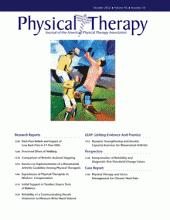Abstract
Background Geriatric rehabilitation reimbursement increasingly requires documented deficits on standardized measures. Tandem stance performance can characterize balance, but protocols are not standardized.
Objective The purpose of this study was to explore the impact of: (1) initial support to stabilize in position and (2) maximum hold time on tandem stance tests of balance in older adults.
Design A cross-sectional secondary analysis of observational cohort data was conducted.
Methods One hundred seventeen community-dwelling older adults (71% female, 12% black) were assigned to 1 of 3 groups based on the need for initial support to perform tandem stance: (1) unable even with support, (2) able only with support, and (3) able without support. The able without support group was further stratified on hold time in seconds: (1) <10 (low), (2) 10 to 29, (medium), and (3) 30 (high). Groups were compared on primary outcomes (gait speed, Timed “Up & Go” Test performance, and balance confidence) using analysis of variance.
Results Twelve participants were unable to perform tandem stance, 14 performed tandem stance only with support, and 91 performed tandem stance without support. Compared with the able without support group, the able with support group had statistically or clinically worse performance and balance confidence. No significant differences were found between the able with support group and the unable even with support group on these same measures. Extending the hold time to 30 seconds in a protocol without initial support eliminated ceiling effects for 16% of the study sample.
Limitations Small comparison groups, use of a secondary analysis, and lack of generalizability of results were limitations of the study.
Conclusions Requiring initial support to stabilize in tandem stance appears to reflect meaningful deficits in balance-related mobility measures, so failing to consider support may inflate balance estimates and confound hold time comparisons. Additionally, 10-second maximum hold times limit discrimination of balance in adults with a higher level of function. For community-dwelling older adults, we recommend timing for at least 30 seconds and documenting initial support for consideration when interpreting performance.
Footnotes
Dr Hile, Dr Brach, Dr Perera, and Dr Studenski provided concept/idea/research design. Dr Hile, Dr Brach, Dr Perera, Dr VanSwearingen, and Dr Studenski provided writing. Dr Hile, Dr Brach, Dr Wert, and Dr Studenski provided data collection. Dr Brach, Dr Perera, and Dr Studenski provided data analysis. Dr Hile and Dr Brach provided project management. Dr Brach and Dr Studenski provided fund procurement and study participants. Dr Studenski provided facilities/equipment. Dr Brach, Dr Perera, Dr Wert, and Dr VanSwearingen provided consultation (including review of manuscript before submission).
This cross-sectional analysis and the larger cohort study from which it was derived were approved by the University of Pittsburgh Institutional Review Board.
This work was funded by the Pittsburgh Claude D. Pepper Older Americans Independence Center (OAIC-NIA P30 AG024827; principal investigator: Dr Studenski), the National Institutes on Aging and American Federation of Aging Research Paul Beeson Career Development Award (K23 AG026766; principal investigator: Dr Brach), and a Training in Aging Research for MD Investigators Award (K07AG023641; principal investigator: Dr Studenski). Funding from all sources provided salary support for the investigators and other research staff, remunerated participants for time and travel, purchased equipment, and paid for management and analyses of data.
- Received September 2, 2011.
- Accepted June 21, 2012.












